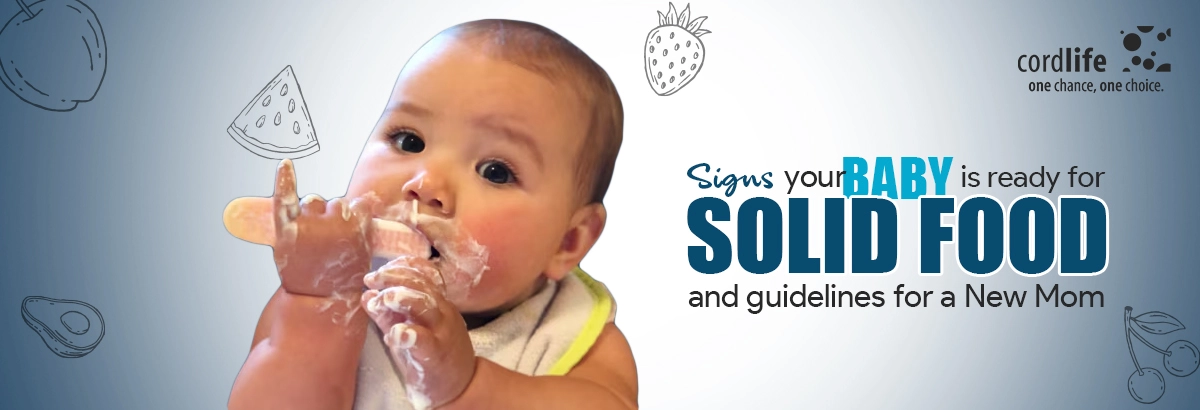Table of Contents
As soon as your baby reaches the half-year mark, you will see him or her sitting without assistance, following objects with their eyes, recognizing faces, teething, and saying “ma” and “da”.
You can now experiment with your little one’s taste buds – from savoury cheese to scrambled eggs. There’s a range of flavours, and your baby can start with solid food. Start eating solid food for your baby is the first step. The trick is to feed the taste buds of your baby.
You only need to know how and when to start solid food for a smooth transition.
When to Start Solid Food For Your Baby?
According to the American Academy of Paediatrics (AAP), you need to breastmilk your little one between 4 and 6 months old exclusively. Simultaneously, you’d need to encourage your baby’s taste buds with solid foods for your baby’s healthy growth and nutrition.
However, you need to understand whether your little one is obese, has belly pain, or chokes while eating food.
To make your work easier, here’s how to start eating solid food for your baby.
By 4, 5, or 6 months old, he can hold his head up and sit up. Once you start feeding solid food pureed veggies, and meats, it will go down via the gravitational force. Chunky food can wait until 7 months old.
If you’re feeding the baby with a fork or spoon, they will follow the fork head and will slowly open their mouth to take a bite.
Use their curiosity. They will be interested in knowing what they eat. So, you can try your luck with finger foods like bananas, avocados or rice puffs. You can also try ground or mashed foods like chicken, turkey, etc.
- Feed the baby with solid food, when their tongue thrust reflex disappears. That means, the tongue moves forward from the month while both the mouth and tongue try to adjust to breast and bottle feeding. In the absence of this instinct, your baby does not instinctively push back the spoon of food.
- Introduce solid food when the little one mimics you during mealtime. During a meal, the child observes you eating just like you.
How to Start Solid Food for Your 6-month-old?
Introducing solids to your 6-month-old is slow. Then the little one learns to eat alone. But, before that, here are the guidelines for starting a solid for your baby:
The Time is Right
Your baby’s most appropriate time to feed is the time that works for your family. But, if you’re breastfeeding, try giving solid food to the baby when the breastmilk supply is low. So, as an experiment, you can offer solid food to your baby in the morning during breakfast. Along with this, start with a meal a day and then move up to two.
Check Your Baby’s Mood
A 6-month-old may be fussy, or sleepy while breastfeeding or bottle-feeding. So, keep an eye on the baby’s mood. Don’t give solid food when the child is cranky. Try to offer the same meal in the next hour. This could be a challenge, but fun at the same time.
Don’t Be Fast
Your 4 to 6-month-old won’t be able to eat fast. But, you can’t be surprised by how long your baby takes to finish one small spoonful. Have patience! Give yourself and the baby enough feeding time.
Say “no” to Silver Spoons
Instead, give them food with plastic, silicone, or corn-based models. Start counting feeds on the gentle gums. One feed comes from your hands, one from your baby’s or lands on the floor. This will boost the child’s independence. In all this, remember to put a bib.
Introduce a Few Things
Before introducing the spoon, take a dab of food and put it on the table, or the tray, and give your baby a chance to try it. Allow the baby to mash the food, rub, squish, and taste it.
Take It Easy
Your little one is accustomed to spoon-feeding. Along with spoon feeding, you will also have a variety of textures with it. So, take it slowly. Place a quarter teaspoon of food on the baby’s tongue tip. Once your little one finishes that, offer him the teaspoon. Eventually, your baby will get used to spoon-feeding.
Count the Rejections
Your baby may reject many solid foods as a new solid foods eater. Even the taste of new food. It’s best to accept rejections and not force the child to accept them. Give it another try.
Learn to See When Your Baby is Done With the Food
While you feed your baby slowly, you need to take clues from his or her signs as to when he or she should be finished. The baby may turn their heads while you offer food to your baby. He or she may even clench his mouth when you give solid food to your baby. Forcing a cute, cuddly baby to eat can lead to future food fights which may not be very healthy for the baby.
Needn’t Worry About the Portions of Food You’re Offering
Since you’re experimenting with solid food, there may be instances when most of the food you’re serving may fall on the floor or go unattended. You can experiment with your baby’s food. You can check by offering more or less food to your baby.
Prepare mashed bananas, peaches, and pears. Go for veggies of different colours – sweet potatoes, carrots, peas, and string beans with a strong flavour. You can also offer whole-grain rice, oats or barley. Minced meat, mashed eggs, cheese, pasta, etc. can also be on the list.
Starting solids for your 5 or 6-month-old is a challenge. You must overcome all the challenges and offer solid food to your baby. Just have a little patience!
